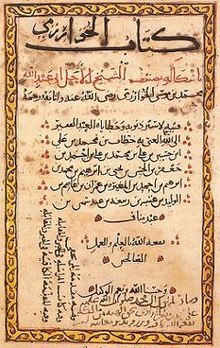
Back الرياضيات في عصر الحضارة الإسلامية Arabic Orta əsrlərdə İslam ölkələrində riyaziyyat Azerbaijani মধ্যযুগীয় ইসলামে গণিত Bengali/Bangla Matematika u srednjovjekovnom islamskom svijetu BS Matemàtiques a l'islam medieval Catalan Arabisk matematik Danish Mathematik in der Blütezeit des Islam German Matemática islámica Spanish ریاضیات قدیمه در جهان اسلام Persian Arabiankielinen matematiikka keskiajalla Finnish

Mathematics during the Golden Age of Islam, especially during the 9th and 10th centuries, was built upon syntheses of Greek mathematics (Euclid, Archimedes, Apollonius) and Indian mathematics (Aryabhata, Brahmagupta). Important developments of the period include extension of the place-value system to include decimal fractions, the systematised study of algebra and advances in geometry and trigonometry.[1]
The medieval Islamic world underwent significant developments in mathematics. Muhammad ibn Musa al-Khwārizmī played a key role in this transformation, introducing algebra as a distinct field in the 9th century. Al-Khwārizmī's approach, departing from earlier arithmetical traditions, laid the groundwork for the arithmetization of algebra, influencing mathematical thought for an extended period. Successors like Al-Karaji expanded on his work, contributing to advancements in various mathematical domains. The practicality and broad applicability of these mathematical methods facilitated the dissemination of Arabic mathematics to the West, contributing substantially to the evolution of Western mathematics.[2]
Arabic mathematical knowledge spread through various channels during the medieval era, driven by the practical applications of Al-Khwārizmī's methods. This dissemination was influenced not only by economic and political factors but also by cultural exchanges, exemplified by events such as the Crusades and the translation movement. The Islamic Golden Age, spanning from the 8th to the 14th century, marked a period of considerable advancements in various scientific disciplines, attracting scholars from medieval Europe seeking access to this knowledge. Trade routes and cultural interactions played a crucial role in introducing Arabic mathematical ideas to the West. The translation of Arabic mathematical texts, along with Greek and Roman works, during the 14th to 17th century, played a pivotal role in shaping the intellectual landscape of the Renaissance.
- ^ Katz (1993): "A complete history of mathematics of medieval Islam cannot yet be written, since so many of these Arabic manuscripts lie unstudied... Still, the general outline... is known. In particular, Islamic mathematicians fully developed the decimal place-value number system to include decimal fractions, systematised the study of algebra and began to consider the relationship between algebra and geometry, studied and made advances on the major Greek geometrical treatises of Euclid, Archimedes, and Apollonius, and made significant improvements in plane and spherical geometry."
^ Smith (1958), Vol. 1, Chapter VII.4: "In a general way it may be said that the Golden Age of Arabian mathematics was confined largely to the 9th and 10th centuries; that the world owes a great debt to Arab scholars for preserving and transmitting to posterity the classics of Greek mathematics; and that their work was chiefly that of transmission, although they developed considerable originality in algebra and showed some genius in their work in trigonometry." - ^ Lumpkin, Beatrice; Zitler, Siham (1992). "Cairo: Science Academy of the Middle Ages". In Van Sertima, Ivan (ed.). Golden age of the Moor, Volume 11. Transaction Publishers. p. 394. ISBN 1-56000-581-5. "The Islamic mathematicians exercised a prolific influence on the development of science in Europe, enriched as much by their own discoveries as those they had inherited by the Greeks, the Indians, the Syrians, the Babylonians, etc."